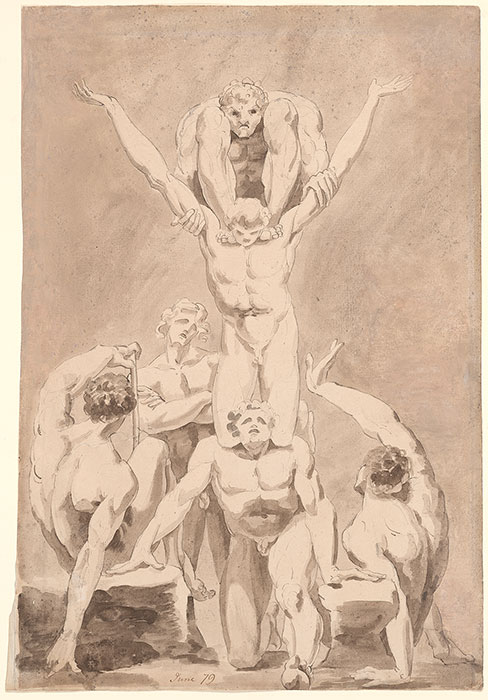
The Acrobats was likely originally part of an album, now dismembered, acquired by Roland Browse and Delbanco Gallery, London, and exhibited in 1949. None of the sheets that composed the volume are signed, but many, including the Acrobats, are dated June or July 1779. Various attempts have been made to identify the author of the drawings contained in the album, who was generically identified as “The Master of the Giants” because of the fantastically exaggerated nudes that characterize the works. Nancy Pressly attributed all the sheets of the volume to the British artist James Jefferys (1751- 1784) (see Nancy L. Pressly, “'James Jefferys and the 'Master of the Giants',” Burlington Magazine 119 (1977), 280, 282-285), while both Leonard Duke and Frederick Antal suggested that some of the drawings might be the work of Prince Hoare. While the attribution to Jeffreys is hard to sustain, nor can the drawings be definitively attributed to Hoare. Still, while is possible that they are the work of an otherwise unknown artist, Hoare appears to be the most likely candidate.
The son of the portrait painter William Hoare (1702-92), Prince Hoare is best known for the drawings he produced during his association with the Fuseli circle in the 1770s. Having entered the Royal Academy schools in 1773, Hoare travelled to Italy in 1776, visiting first Florence and then settling in Rome, where he remained until 1779. Here he frequented the group of British artists who worked there, becoming particularly close friends with James Northcote (with whom he studied under Mengs), Alexander Day, Thomas Banks, and others, and also with the Swedish draftsman/sculptor Johan Tobias Sergel. Northcote records their frequent trips to draw in the Sistine Chapel (James Northcote, Memoir, British Library, Add MS 47791, vol. 2). The Acrobats presents in fact obvious debts Michelangelo's inventions, and it has been noted that the figure at the top of the composition recalls one of the damned from the Last Judgement, while the two supporting nudes recall ignudi from the Sistine ceiling. A rich cache of letters in the Beinecke Library at Yale documents Hoare's life in Rome (see John Marciari, Grand Tour Diaries and Other Travel Manuscripts in the...Osborn Collection (New Haven, 1999), nos. 143-59), as does his Roman sketchbook, now in the Victoria and Albert Museum. Upon his return to London, Hoare continued an artistic career but became better known as a writer and impresario for the London theatre scene, and as a leading member of the Royal Academy, Society of Antiquaries, and Royal Society of Literature.
